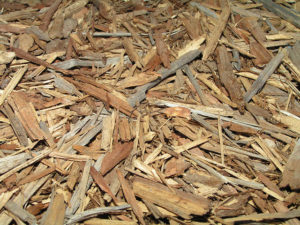In my last post I mentioned that I would look for ways to reduce our exposure to and production of PAHs, and I’ve spent some time searching for specific campaigns, but I haven’t found much that seems like an organized approach. Instead, I found a number of smaller recommendations for individual action.
To reduce exposure from food:
- CNN.com has suggestions on safer grilling techniques, including the use of gas and propane instead of charcoal or using chimney starters instead of lighter fuel. There are also certain marinades that can prevent charring of meat.
- prevention.com has another marinade suggestion for the beer-drinkers among us.

Cedar chips help deter moths and don’t release dangerous PAHs. Photo by Michael Fienen- license
Cutting general levels in your home:
- The Illinois Dept. of Public Health recommends using cedar chips in place of mothballs.
- The New South Wales EPA recommends reducing the use of wood for heating.
- According to recent research by Kati Nuutinen, there are several technological options for reducing PAH-production by wood-fired appliances which can help make the air in your home cleaner.
Reducing overall pollution levels in air, water, and soil:
- The Minnesota Pollution Control Agency promotes reducing the use of coal tar sealcoats for asphalt.
- The Columbia Center for Children’s Environmental Health advocates for better emission controls in vehicles and limits to engine idling.
- The Breast Cancer Fund suggests we can each cut down on vehicle emissions by biking, walking, or using hybrid/electric or public transportation.
- Another option for reducing PAH emissions is a familiar message from an old friend- don’t start forest fires.
Some of these suggestions probably seem common sense, but they are worth repeating. And it does really seem like each of us has an individual responsibility to cut back on the emissions we, personally, generate. At the same time, large-scale policies for PAH reduction, for example through vehicle regulation, will probably take concerted and united effort, so we need to look for ways to make that happen, too.
